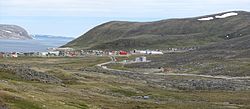Kangiqsujuaq
ᑲᖏᕐᓱᔪᐊᖅ | |
|---|---|
 | |
| Coordinates (901, chemin Sinaitia[1]): 61°36′N 71°58′W / 61.600°N 71.967°W[2] | |
| Country | |
| Province | |
| Region | Nord-du-Québec |
| TE | Kativik |
| Constituted | September 20, 1980 |
| Government | |
| • Mayor | Charlie Arngak |
| • Federal riding | Abitibi—Baie-James—Nunavik—Eeyou |
| • Prov. riding | Ungava |
| Area | |
• Total | 12.60 km2 (4.86 sq mi) |
| • Land | 12.31 km2 (4.75 sq mi) |
| Population (2021)[4] | |
• Total | 837 |
| • Density | 67.5/km2 (175/sq mi) |
| • Pop 2006-2011 | |
| • Dwellings | 321 |
| Time zone | UTC−5 (EST) |
| • Summer (DST) | UTC−4 (EDT) |
| Postal code(s) | |
| Area code | 819 |
| Highways | No major highways |
| Website | www |
Kangiqsujuaq (Inuktitut: ᑲᖏᕐᓱᔪᐊᖅ) is a northern village (Inuit community) in Nunavik, Nord-du-Québec, Quebec, Canada. It had a population of 837 in the Canada 2021 Census. The community has also been known as Wakeham Bay. The name "Kangiqsujuaq" means "the large bay" in Inuktitut.[5]
It is located on the Ungava Peninsula, on the Cap du Prince-de-Galles on the Hudson Strait. It is served by the small Kangiqsujuaq Airport.
During winter, when the tides are extremely low, local Inuit sometimes climb beneath the shifting sea ice to gather blue mussels. They break holes in the ice and then can walk for a short time on the exposed sea bed and collect this food. This risky way of gathering the mussels goes back for generations.[6]
As the other villages of the Kativik region, the Kativik Regional Police Force provides police services in Kangiqsujuaq.[7]
Kangiqsujuaq is the closest community to the Qajartalik archaeological site, a site featuring petroglyphs created by the Dorset culture.[8] In 2017, it was announced that the Qajartalik would be added to Canada's tentative list for nomination to the UNESCO World Heritage Site list.[9]

- ^ a b c Cite error: The named reference
mamrotwas invoked but never defined (see the help page). - ^ Cite error: The named reference
toponymiewas invoked but never defined (see the help page). - ^ Cite error: The named reference
cp2021was invoked but never defined (see the help page). - ^ "Census Profile, 2021 Census - Kangiqsujuaq, Village nordique [Census subdivision], Quebec and Nord-du-Québec, Census division [Census division], Quebec". 9 February 2022.
- ^ "Kangiqsujuaq - Community in Nunavik, Northern Arctic Quebec". www.nunavik-tourism.com. Archived from the original on 2017-07-06. Retrieved 2017-07-03.
- ^ "Inuit's risky mussel harvest under sea ice". BBC News. 25 January 2011. Retrieved 25 January 2011.
- ^ KRPF. "General Information". Home. Retrieved 2017-07-03.
- ^ "Protection and development of the Qajartalik petroglyph site (JhEv-1)". Avataq Cultural Institute. Avataq Cultural Institute. Retrieved 9 June 2018.
- ^ "Canada puts forward 8 UNESCO recommendations". CBC News. 20 December 2018. Retrieved 17 May 2018.
